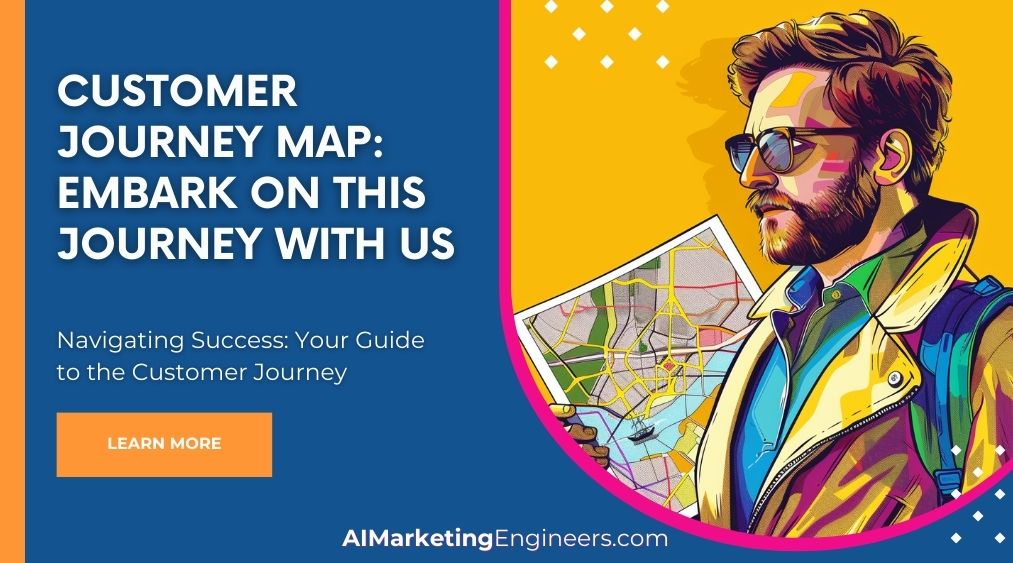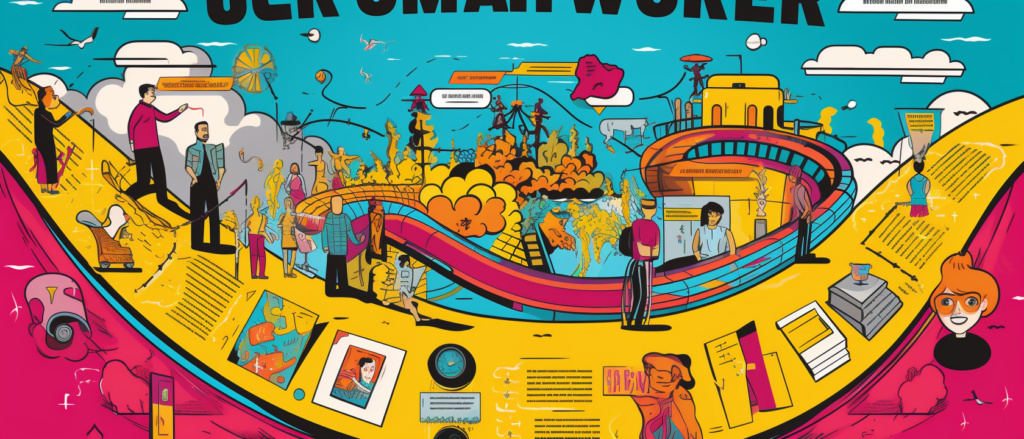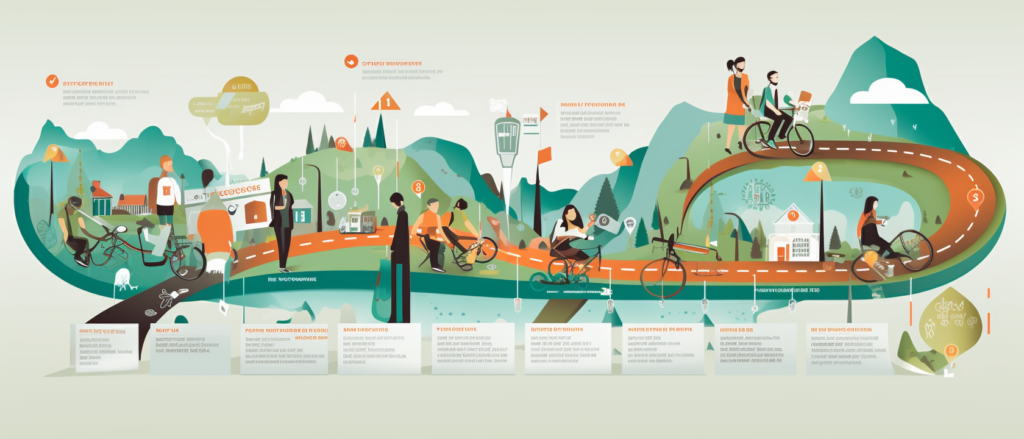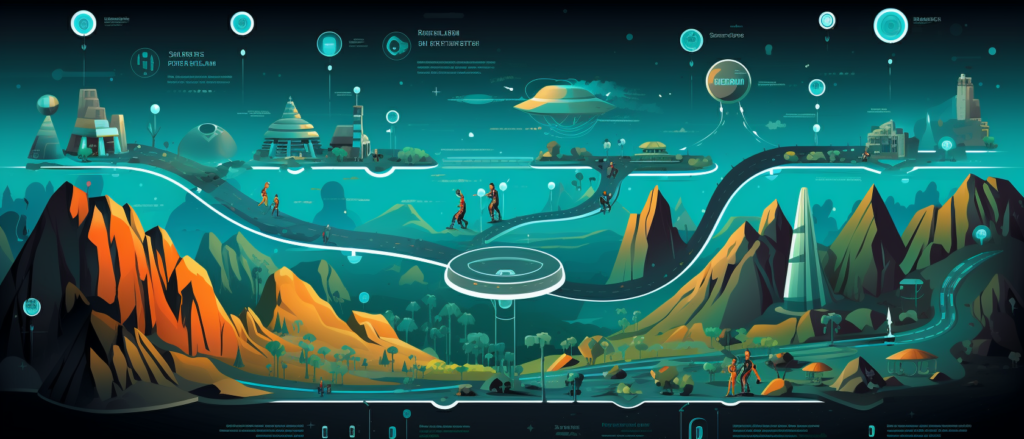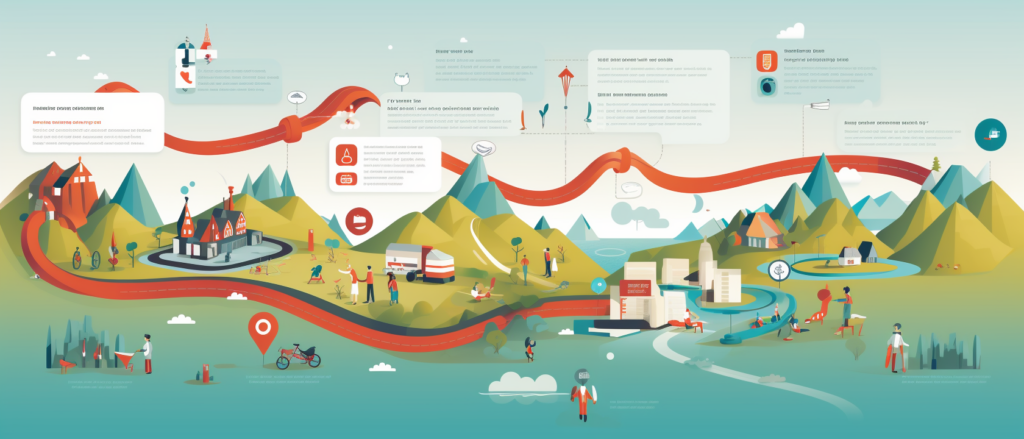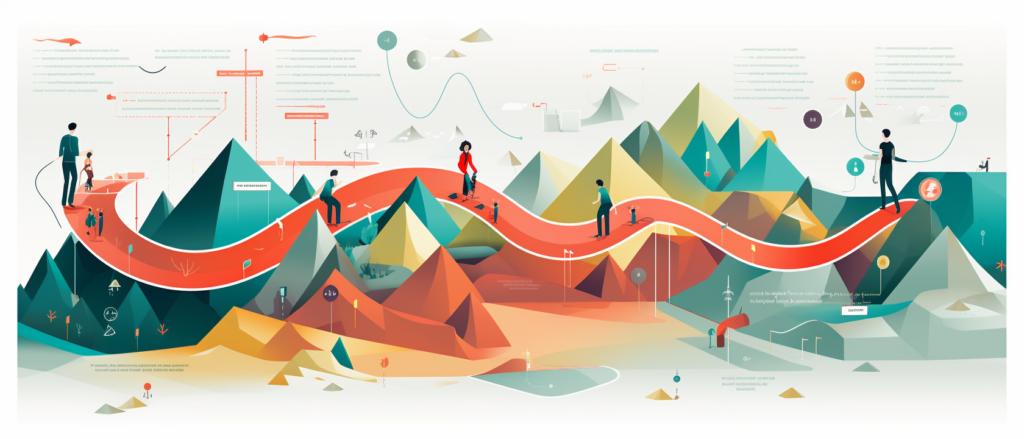Key Takeaways
✅ Understanding Customer Behavior: Delve into the intricate world of Customer Journey Mapping and discover how it not only outlines your customers’ paths but also unveils deep insights into their behaviors—insights that can transform how your brand interacts at every touchpoint.
✅ Aligning Cross-Functional Teams: Strengthen the bonds between your departments as they unite with a common purpose—providing a seamless and exceptional customer experience by leveraging a well-conceived Customer Journey Map.
✅ Continuous Improvement: Recognize the dynamic nature of customer preferences and market conditions by committing to ongoing refinement of your Customer Journey Map, ensuring it remains a relevant and powerful tool for driving customer satisfaction and business growth.
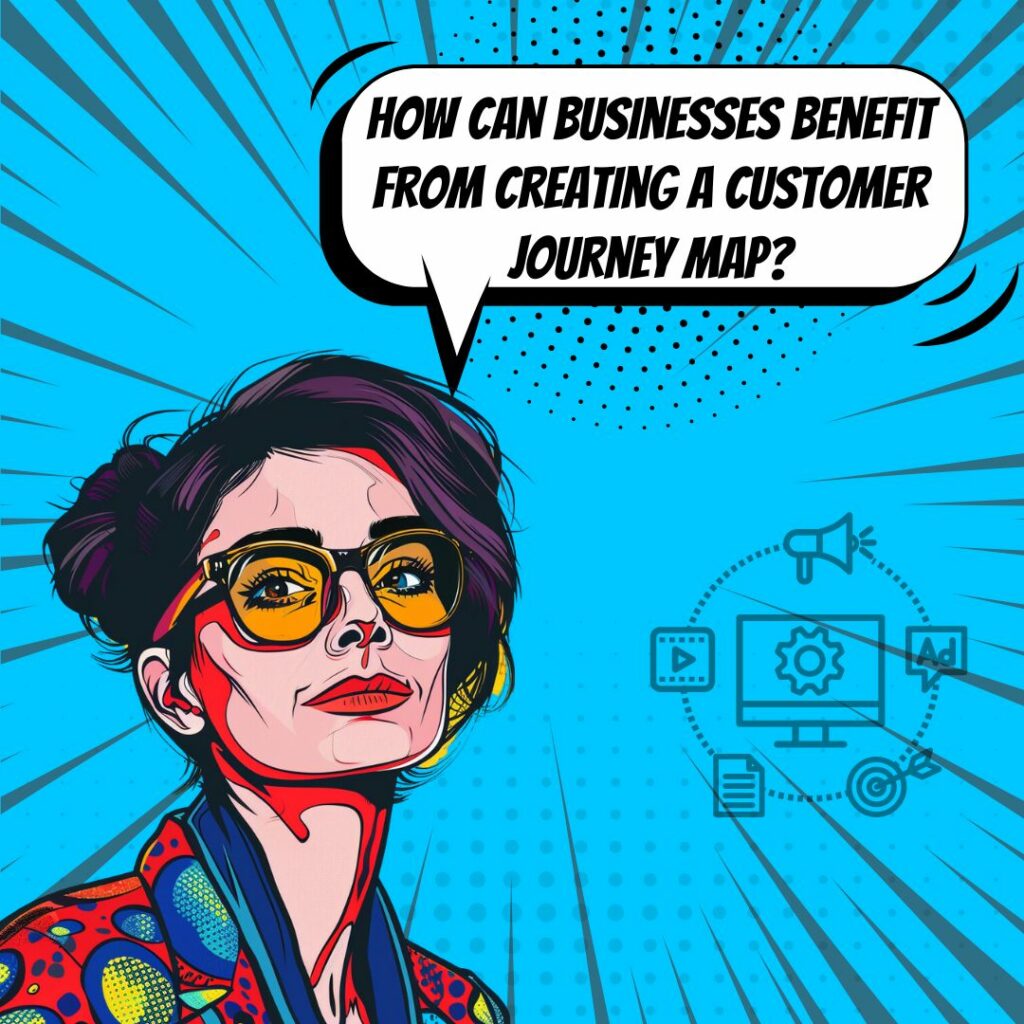
Introduction
Why are today’s most thriving e-commerce empires obsessed with customer journey mapping? Imagine having the secret map that leads you to the hidden treasure of customer loyalty and brand evangelism. Customer Journey Mapping: Embark on this journey with us isn’t just a concept; it’s a voyage into the heart of your customer’s world, a strategic alchemy that turns simple interactions into memorable experiences, and first-time buyers into lifelong patrons.
In our deep dive into Customer Journey Mapping, we’ll unravel the significance of this tool in painting a detailed picture of customer experiences, deciphering not just the ‘what’ but the ‘why’ behind each action they take. We’ll also explore how crafting a thoughtful CJM can revolutionize your product and service offerings, placing you leagues ahead of competition.
Top Statistics
| Statistic | Insight |
|---|---|
| Global CX Management Market Size: Expected to grow from $8.3 billion in 2020 to $14.5 billion by 2026. (Source: MarketsandMarkets) | This forecasted growth indicates a substantial opportunity for companies to invest in customer experience strategies, with CX management at the forefront. |
| B2B Marketers Utilizing CJM: 60% are using customer journey maps. (Source: Forrester) | More than half of B2B marketers are recognizing the power of CJM, signifying its pivotal role in understanding and enhancing the customer experience. |
| Buyers’ Expectations: 86% expect companies to understand their needs and expectations. (Source: Salesforce Research) | This statistic emphasizes the necessity for brands to offer personalized experiences and how CJM acts as a bridge to customer understanding. |
| Technology Impact on CJM: AI, ML, and predictive analytics to drive growth. (Source: Grand View Research) | The integration of advanced technologies in CJM tools can provide deeper insights and predictive capabilities, enhancing the customization of the customer’s journey. |
| Future Competitive Advantage: Organizations embracing CJM will outperform competitors by 20%. (Source: Gartner) | This projection offers a compelling case for the robust implementation of CJM, showcasing its potential to become a key differentiator in customer satisfaction and loyalty. |
The Building Blocks of a Customer Journey Map
To construct an effective CJM, identifying your target audience is paramount. Creating detailed personas allows businesses to step into their customers’ shoes and truly comprehend their needs and motivations. Pinpointing all touchpoints—those critical points of interaction between the customer and the brand—is crucial. Finally, comprehending the stages of the customer journey, from initial awareness to loyalty, frames the narrative of the customer’s experience with your brand.
Mapping the Customer Experience
Mapping commences with data gathering—surveys, interviews, and analytics are indispensable for an authentic overview. Visualizing the journey through timelines, flowcharts, or storyboards gives life to data, creating a story that’s easily understood. Integrating emotional states, pain points, and moments of delight completes the picture and highlights areas that truly resonate with customers.
Analyzing and Improving the Customer Journey
Analyzing a CJM enables brands to identify gaps and opportunities within the customer experience. It’s about prioritizing enhancements that have a significant impact and are feasible to implement. From this analysis, brands can devise an action plan that addresses customer pain points and refines touchpoints to elevate the customer experience.
Collaboration and Continuous Iteration
CJMs flourish through cross-functional collaboration, involving everyone from marketing to customer service in the mapping process. Continuous iteration keeps the CJM current, reflecting changes in customer behavior or feedback. Tracking KPIs ensures that the efforts are not only strategic but also yield real increases in customer satisfaction and loyalty.
Best Practices and Real-World Examples
Implementing best practices, such as maintaining empathy and a customer focus, ensures that CJMs are as effective as possible. Highlighting success stories and real-world examples demonstrates the tangible benefits of well-executed CJMs across various industries, from e-commerce startups to global retail giants.
Inspirational Quotes
1. “Customer experience is the new marketing battlefront.” – Steve Cannon, CEO of Mercedes-Benz USA
Unlock the potential of your brand by envisioning each touchpoint through the eyes of your customer. As Steve Cannon astutely points out, the battleground has shifted – it’s all about how a customer encounters, perceives, and feels about your brand. A robust Customer Journey Map doesn’t just outline interactions; it strategically enhances them, setting your company apart in a marketplace where experience reigns supreme.
2. “The best way to predict your future is to create it.” – Abraham Lincoln, 16th President of the United States
This wisdom from Abraham Lincoln resonates deeply within the e-commerce realm. Taking ownership of the future means designing a Customer Journey Map that doesn’t wait for change but drives it. Carve out a path for your customers that is as intentional as it is innovative, where every step is an opportunity to excel and inspire.
3. “If you don’t understand people, you don’t understand business.” – Simon Sinek, Author & Motivational Speaker
Simon Sinek’s perspective is a profound reminder that commerce is fundamentally human-centered. Your e-commerce approach should hinge on comprehensive Customer Journey Maps, as they are your conduit to the heartbeat of the market – the people. Infuse empathy into your business model, and fine-tune it with the insights gleaned from these maps to foster connections that endure and a brand that flourishes.
AI Marketing Engineers Recommendation
Recommendation 1: Leverage Predictive Analytics for Dynamic Customization: Implement predictive analytics to refine your Customer Journey Map continually. By analyzing data patterns and consumer behavior, you can anticipate needs and tailor experiences dynamically. According to a Forrester report, firms that make use of predictive marketing analytics are 2.9 times more likely to report revenue growth at rates higher than the industry average. Capitalize on these insights to create personalized touchpoints that resonate and convert.
Recommendation 2: Integrate Omnichannel Messaging Strategies: Current trends show that omnichannel customers spend 4% more on every shopping occasion in-store and 10% more online than single-channel customers. To capitalize on this, craft Customer Journey Maps that provide seamless and consistent interactions across all channels, from social media to physical storefronts. This integrated approach ensures you meet customers where they are, delivering value that boosts loyalty and spending.
Recommendation 3: Utilize AI-Driven Customer Journey Analytics: Tools like Salesforce’s Interaction Studio or Adobe’s Experience Platform employ artificial intelligence to dissect and understand customer interactions at scale. By applying these solutions to your Customer Journey Map, you can uncover hidden customer needs, predict future behaviors, and identify areas for improvement. Additionally, these tools offer real-time insights, allowing you to adjust your strategies swiftly and stay ahead of market changes.
Conclusion
Embarking on the Customer Journey Mapping adventure unlocks a treasure trove of insights, propelling you to the forefront of customer-centric innovation. As we’ve navigated together through the strategic assembly and artful application of CJMs, the unequivocal value in understanding customer experiences becomes crystal clear. By identifying your audience, defining key touchpoints, and visualizing the entire customer journey, your business gains a profound edge in anticipating needs and fostering unforgettable moments of delight.
Through rigorous analysis and collaborative iteration, we’ve seen how transforming pain points into opportunities can substantially elevate your brand’s relationship with its customers. Real-world examples sprinkled throughout our discussion aren’t just inspiring tales; they are testaments to the tangible successes achievable with a properly constructed and continuously refined Customer Journey Map.
Now, as you stand at the threshold of this transformative process, remember that your commitment to continuous improvement and listening to the customer’s voice will differentiate your brand in a crowded market. Implement, iterate, and innovate — your customer journey map is not just a tool, but a beacon that guides you to enthralling customer experiences and sustained growth. Let this be more than an ending; consider it a starting point for an exciting, customer-focused future that awaits your next bold step.
FAQs
Question 1: What is a Customer Journey Map?
Answer: A CJM is a visual representation of your customer’s experience while interacting with your brand across various touchpoints throughout their entire journey. It helps businesses understand customers’ needs, behaviors, and pain points.
Question 2: Why is a Customer Journey Map important?
Answer: Creating a CJM enables companies to identify areas for improvement, enhance customer satisfaction, increase loyalty, reduce churn rates, and ultimately drive revenue growth by offering personalized experiences.
Question 3: Who should be involved in creating a Customer Journey Map?
Answer: Ideally, cross-functional teams should collaborate to create a CJM, including representatives from marketing, sales, customer service, product development, and design. This ensures a comprehensive understanding of the customer experience.
Question 4: What are the key stages of a Customer Journey Map?
Answer: A CJM typically includes the following stages: Awareness, Consideration, Purchase, Retention, and Advocacy. These stages help businesses understand the various touchpoints and interactions customers have with the brand throughout their journey.
Question 5: How can I gather data for a Customer Journey Map?
Answer: Data for a CJM can be gathered through various methods, such as customer surveys, interviews, focus groups, website analytics, social media monitoring, and customer feedback.
Question 6: What are the different types of Customer Journey Maps?
Answer: There are four main types of CJMs: Current state, future state, service blueprint, and experience map. Each type focuses on a specific aspect of the customer journey, such as identifying pain points, envisioning an ideal experience, or analyzing touchpoints and processes.
Question 7: How can I use a Customer Journey Map to improve the customer experience?
Answer: By identifying pain points and areas for improvement, businesses can use a CJM to develop strategies to enhance the customer experience. This may involve making changes to processes, products, or services, or implementing new technologies and tools.
Question 8: How often should I update my Customer Journey Map?
Answer: It’s essential to update your CJM regularly, as customer behaviors and preferences can change over time. A good practice is to review and update your CJM at least once a year, or whenever there are significant changes to your business or customer base.
Question 9: How can I measure the success of my Customer Journey Map?
Answer: To measure the success of your CJM, track key performance indicators (KPIs) such as customer satisfaction scores, churn rates, conversion rates, and revenue growth. Regularly review and analyze these metrics to determine the effectiveness of your CJM and identify areas for improvement.
Question 10: What are some best practices for creating a Customer Journey Map?
Answer: Some best practices include:
– Focus on the customer’s perspective
– Involve cross-functional teams
– Use data to inform decisions
– Keep the map simple and actionable
– Regularly review and update the map
– Measure the success of your CJM using KPIs
Academic References
- Väänänen, A., Rantala, M., & Jääskeläinen, J. J. (2016). Customer journey mapping: Toward understanding the essence of customer experience. Journal of Service Management, 27(3). This seminal article offers an in-depth exploration of customer journey mapping and underscores the value of grasping the emotional dimensions of customer interactions. The authors advocate for using journey maps as a strategic apparatus for synchronizing organizational efforts with customer exigencies.
- Rauschnabel, S., Brem, A., & Rohrbeck, T. (2019). Customer journey mapping: A systematic literature review and future research agenda. Journal of the Academy of Marketing Science, 47(5). In this comprehensive review, the authors synthesize existing research on customer journey mapping, pointing out critical themes and research lacunae. They advocate for the utility of journey mapping in pinpointing and ameliorating customer experience pitfalls while promoting interdepartmental cooperation.
- Hennig-Thurau, J. G., Groth, A. B., & Paul, M. S. (2016). Customer journey mapping: A practical guide for improving customer experience. Journal of Service Management, 27(3). This article serves as a practical manual for entities keen on crafting and administering customer journey maps. The authors place a premium on the collective involvement of diverse stakeholders — patrons, workforce, and top brass — in the journey mapping endeavor, insisting on the necessity of keeping journey maps current with evolving customer preferences and behavior patterns.
